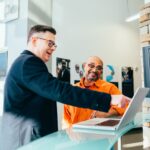When it comes to dental implants, one of the key factors that determines the success of the procedure is the health and quality of the jawbone. Dental implants rely on a strong, stable foundation to integrate with the bone through a process known as osseointegration. However, many patients may not have enough bone in their jaw to support the implants, whether due to bone loss from injury, gum disease, or long-term tooth loss. This is where bone grafting comes into play.
Bone grafting is a procedure that can help restore the lost bone in the jaw, enabling successful implant placement. By using bone from the patient, a donor, or synthetic materials, bone grafting provides the necessary volume and density for dental implants to be securely placed. At the Center For Implant Dentistry, we specialize in both bone grafting and dental implants, offering our patients a comprehensive solution to tooth loss that provides long-term, stable results.
In this article, we will explore how bone grafting works, why it’s necessary for dental implants, the different types of bone grafts available, and how bone grafting enhances the success of dental implants.
What Is Bone Grafting?
Bone grafting is a surgical procedure used to rebuild or regenerate bone in areas where it has been lost or damaged. In the context of dental implants, bone grafting is used to create a stable base for implant posts in the jawbone. Without enough healthy bone in the jaw, dental implants cannot be successfully placed, as they need sufficient bone to anchor the implant securely.
The process of bone grafting involves placing bone graft material into the area where bone is needed. Over time, this material will integrate with the surrounding bone, creating a stronger, more stable foundation for implants. Bone grafting can be performed before implant placement or in conjunction with the dental implant procedure itself, depending on the condition of the patient’s bone.
Why is Bone Grafting Necessary for Dental Implants?
Dental implants require a healthy, dense jawbone to support the titanium posts that act as artificial tooth roots. If the jawbone is insufficient or has deteriorated, dental implants cannot be securely placed. Bone loss can occur for several reasons, including:
- Tooth Loss: When a tooth is lost, the bone that once supported it begins to shrink or resorb. Over time, this can lead to significant bone loss in the area.
- Gum Disease: Advanced periodontal disease can cause the gums and bone to deteriorate, making it difficult to place implants successfully.
- Injury or Trauma: Accidents, fractures, or other injuries can lead to bone loss in the jaw, requiring grafting to restore bone volume.
- Age: As we age, the bone in the jaw naturally becomes less dense, which can lead to a lack of sufficient bone for implants.
Bone grafting addresses these issues by rebuilding the bone in the jaw, providing a stable foundation for dental implants. Without this procedure, patients may not be candidates for dental implants, even if they have a desire for permanent tooth replacement.
Types of Bone Grafts Used in Dental Implant Procedures
There are several different types of bone grafts that can be used depending on the patient’s needs and the location of the bone loss. The choice of bone graft material depends on factors such as the severity of bone loss, the patient’s health, and the area where the graft is needed. The main types of bone grafts include:
- Autografts: Autografts are bone grafts taken from the patient’s own body. This type of graft has the highest success rate because the body recognizes its own bone as compatible. Common donor sites for autografts include the chin, jaw, or hip. Although autografts have a high success rate, they do require a second surgical site for bone removal, which can extend recovery time.
- Allografts: Allografts are bone grafts harvested from a donor, usually a cadaver. These grafts are carefully processed and sterilized to ensure that they are safe for use. Allografts are an excellent option for patients who may not have enough bone in their body for an autograft. They provide a solid foundation for implants, although they may not integrate as quickly as autografts.
- Xenografts: Xenografts are bone grafts derived from animals, typically cows. Like allografts, xenografts are processed to ensure they are safe for use in humans. These grafts are often used when autografts or allografts are not an option, providing an alternative for patients who need bone regeneration in areas of the jaw with significant bone loss.
- Alloplasts: Alloplasts are synthetic bone grafts made from biocompatible materials such as calcium phosphates. These grafts are designed to mimic the properties of natural bone and can be a suitable option for patients who require less invasive procedures or who are unable to use natural bone grafts. While alloplasts may not integrate as quickly as natural bone, they can still provide a stable base for implants.
The Bone Grafting Process: What to Expect
The bone grafting procedure is typically performed in stages. The specific details of the procedure will depend on the type of graft used and the patient’s individual needs. Here’s a general overview of what you can expect during the bone grafting process:
- Initial Consultation and Evaluation: Before the procedure, your dentist or oral surgeon will conduct a thorough evaluation to assess the condition of your jawbone. X-rays or 3D scans will help determine the extent of the bone loss and identify the best approach for grafting.
- Grafting Procedure: During the surgery, your dentist will make a small incision in the gum to access the jawbone. The bone graft material will be placed in the areas where bone loss has occurred. In some cases, a membrane may be placed over the graft to aid in healing and prevent soft tissue from interfering with the bone regeneration process.
- Healing Period: After the graft is placed, the area will need time to heal and integrate with the surrounding bone. The healing time can vary depending on the type of graft used and the location of the bone loss. Typically, the healing process takes several months to ensure the graft bonds successfully with the existing bone.
- Implant Placement: Once the graft has fully integrated with the surrounding bone, the dental implant can be placed. This is usually done in a separate procedure, although some patients may have both the bone grafting and implant placement performed during the same surgery. The implants will fuse with the bone over several months, providing a secure foundation for the replacement teeth.
- Final Restoration: After the implants have integrated with the bone, custom-made crowns, bridges, or dentures will be placed on top of the implants to restore the functionality and appearance of your teeth.
The Benefits of Bone Grafting for Dental Implants
Bone grafting is a crucial step in ensuring the long-term success of dental implants. Below are some of the key benefits of bone grafting for patients who are undergoing dental implant procedures:
- Improved Implant Success: Bone grafting ensures that there is sufficient bone for implants to integrate with, increasing the chances of successful osseointegration. Implants that are placed in areas with inadequate bone may fail to properly integrate, leading to complications.
- Preventing Further Bone Loss: Bone grafting helps prevent the continued resorption of bone in the jaw. By restoring bone volume, grafting can maintain the structure of the face and jaw, preventing the sunken appearance that often accompanies tooth loss.
- More Tooth Replacement Options: For patients who have experienced significant bone loss, bone grafting opens up more options for tooth replacement. With sufficient bone volume, patients can be candidates for dental implants, even in areas where implants would otherwise not be possible.
- Better Long-Term Oral Health: By preserving bone health and ensuring proper implant placement, bone grafting contributes to better long-term oral health. Implants offer a stable and durable solution to tooth loss, which reduces the risk of future oral health issues such as tooth shifting, gum disease, or further bone loss.
The Recovery Process: What to Expect
The recovery process for bone grafting and dental implants can vary depending on the extent of the procedure and the individual. Most patients experience some swelling, bruising, and discomfort after the surgery, which can be managed with prescribed pain medications. It’s important to follow your dentist’s aftercare instructions carefully to promote healing and ensure the success of the graft.
After the bone grafting procedure, it’s essential to avoid putting pressure on the surgical site while it heals. Depending on the complexity of the procedure, it may take several months for the bone graft to fully integrate with the surrounding bone.
Once the graft has healed, you’ll be ready for the next steps in the dental implant process, including implant placement and final restoration.
Conclusion
Bone grafting is an essential procedure that enhances the success of dental implants, particularly for patients who have experienced bone loss due to aging, injury, or disease. By providing the necessary bone structure for implant placement, bone grafting ensures that dental implants are securely anchored, providing a long-term solution to missing teeth.
At the Center For Implant Dentistry, we specialize in bone grafting and dental implants, offering comprehensive treatment that restores both the function and appearance of your teeth. If you’re considering dental implants but are concerned about bone loss, contact us today to learn more about how bone grafting can help you achieve a stable, beautiful smile.


